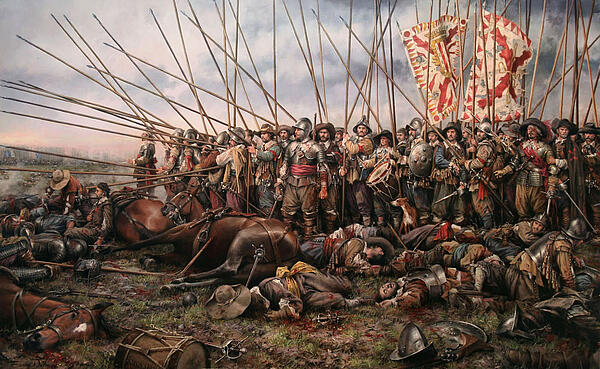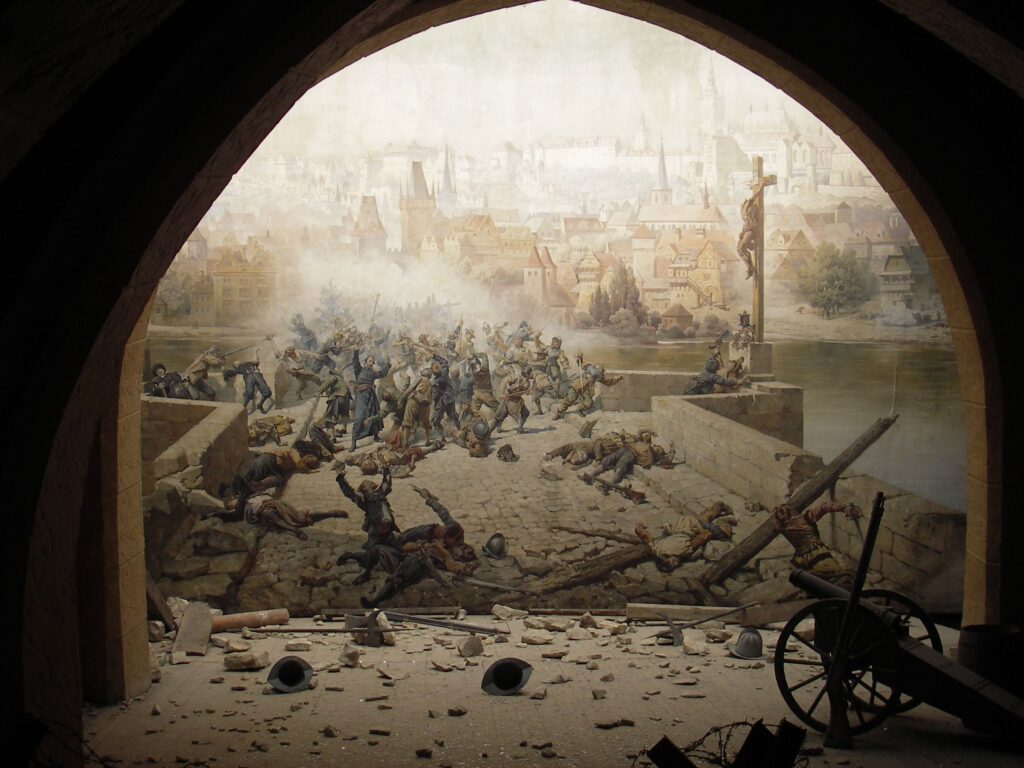Table of Contents
The Treaty of Westphalia began with a series of diplomatic talks initiated as early as 1643, involving major European powers such as Sweden, France, Spain, and the Holy Roman Empire, alongside various German princes, in an effort to bring an end to the ongoing Thirty years war and Eighty years war. The Peace of Westphalia consists of two different documents, the Peace Treaty of Osnabrück between the Holy Roman Empire of the German Nation and Sweden and the Peace Treaty of Münster between the HRE and France.
Treaty of Westphalia develope such principles that became the foundation for modern nation state. Those principles relating to respecting the boundaries of sovereign states and non-interference in their domestic affairs, became central to the world order that developed over the following centuries,and remain in effect today. Its provisions helped to lay the foundation for the idea of the nation-state, with each state having a defined territory, government, and population.
The Peace of Westphalia was a result of Thirty years war. Two destructive wars were the major triggers behind signing the eventual Peace of Westphalia: the Thirty Years’ War in the Holy Roman Empire and the Eighty Years’ War between Spain and the Dutch Republic. The Thirty Years’ War was a series of wars in Central Europe between 1618 and 1648. The war’s roots lay in the religious conflict between Catholics and Protestants that began with the Reformation in the 16th century. War was Fought primarily in Central Europe, an estimated 4.5 to 8 million soldiers and civilians died from the effects of battle, famine, or disease, while parts of Germany reported population declines of over 50%.
Before we find the answer the answer to the question of ” What was the Treaty of Westphalia? (1648). We need to know about Thirty years war.
Thirty years war (1618-1648)
Initially a war between various Protestant and Catholic states in the fragmented Holy Roman Empire, it gradually developed into a more general conflict involving most of the great powers. The war began when the newly elected Holy Roman Emperor, Ferdinand II, tried to impose religious uniformity on his domains, forcing Roman Catholicism on its peoples. The immediate cause of the war was the Defenestration of Prague in 1618. Protestant nobles in Bohemia, angered by the Catholic King Ferdinand II’s efforts to impose Catholicism and restrict their religious freedoms, rebelled against his rule. The northern Protestant states, angered by the violation of their rights to choose granted in the Peace of Augsburg, banded together to form the Protestant Union.

These events caused widespread fears throughout northern and Central Europe and triggered the Protestant Bohemians living in the dominion of Habsburg Austria to revolt against their nominal ruler, Ferdinand II. They removed the Habsburgs and chose Frederick V, Elector of Palatinate, as their new monarch. Frederick accepted the offer without the union’s backing. This decision angered the southern states, which were predominantly Roman Catholic. Led by Bavaria, these states formed the Catholic League to depose Frederick and support the emperor.
The war shifted its focus from religious divisions to becoming a continuation of the France–Habsburg rivalry for political dominance in Europe. Sweden, a major military power in the day, intervened in 1630 under the great general Gustavus Adolphus and started the full-scale great war on the continent. Spain, wishing to finally crush the Dutch rebels in the Netherlands and the Dutch Republic, intervened under the pretext of helping their dynastic Habsburg ally, Austria. No longer able to tolerate the encirclement of two major Habsburg powers on its borders, Catholic France entered the coalition on the side of the Protestants to counter the Habsburg.
The Thirty Years’ War devastated entire regions, with famine and disease significantly decreasing the populations of the German and Italian states, the Crown of Bohemia, and the Southern Netherlands. The war altered the previous political order of European powers. The rise of Bourbon France, the curtailing of Habsburg ambition, and the ascendancy of Sweden as a great power created a new balance of power on the continent, with France emerging from the war strengthened and increasingly dominant in the latter part of the 17th century.
The last major battle of the Thirty Years’ War was the Battle of Prague, fought between July 25 and November 1, 1648. While the negotiations for the Peace of Westphalia were proceeding, the Swedes took the opportunity to mount one last campaign into Bohemia. After occupying the castle of Prague and the western bank of the Vltava for some months, the Swedes stopped assaulting the Old and New Town at the eastern bank when news of the signing of the treaty reached them. They still remained a garrison on the western bank until their final withdrawal on 30 September 1649.

After nearly 30 years of relentless warfare, devastated cities, and millions of lives lost, the warring factions were finally ready to return to the negotiating table in late 1646. Regardless of their side or religion, nearly all duchies and estates had grown weary of the conflict—not only because of the widespread suffering and economic ruin across vast regions of the Holy Roman Empire but also due to the growing futility and senselessness of the endless fighting.
Treaty of Westphalia (1648)
Both Catholics and Protestants sought to resolve the conflict. In Westphalia, located in the western part of the empire, the Catholics gathered in Münster while the Protestants convened in Osnabrück to discuss the prospects of peace. They exchanged envoys and letters, negotiating and advocating for a shared future within the empire.
Lutheran Sweden favored Osnabrück as the venue for its peace negotiations with the Holy Roman Empire and their respective allies, conducting the discussions there. The Holy Roman Empire and its adversary France, along with their respective allies, as well as the Republic of the Seven United Netherlands and its rival Spain (and their allies), held negotiations in Münster. The Peace of Westphalia (1648) ended the Thirty Years War in Europe. Here are a few of its most important statements which the Holy Roman Emperor, the King of France, and the King of Sweden signed to end the
All parties agreed to uphold the Peace of Augsburg of 1555, which granted each prince the authority to determine the religion of their state (the principle of cuius regio, eius religio). However, the ius reformandi was abolished, meaning subjects could no longer be compelled to adopt their ruler’s religion upon conversion. Rulers were now permitted to choose among Catholicism, Lutheranism, and Calvinism.
Sovereignty of the States
The Peace of Westphalia established the concept of state sovereignty, where each state was recognized as having supreme authority within its own territory. This meant that states could govern without external interference, laying the foundation for the modern idea of sovereign nations.
Territorial integrity
The treaties confirmed territorial boundaries and aimed to respect the integrity of each state. Borders were formally recognized, and it was established that no state should interfere in the domestic affairs of another, promoting stability by preventing arbitrary claims over others’ territories.
Legal Equality of states
The Peace of Westphalia introduced the idea that all states, regardless of size or power, were legally equal. This principle promoted a balance of power, where states had equal standing in diplomatic relations, a concept that would become a cornerstone of international law.
Non interference in domestic affairs
The treaties included a commitment to non-interference, meaning that states should not involve themselves in the internal matters of other states, particularly regarding religion and governance. This was revolutionary at the time, as it ended the religious conflicts that had plagued Europe for decades.
Religious tolerance
The Peace of Westphalia allowed for religious freedom within certain limits, especially within the Holy Roman Empire. Rulers were given the right to determine the religion of their own state (cuius regio, eius religio), but they were also required to tolerate minority religions, notably Catholicism, Lutheranism, and Calvinism, within their borders.
Legacy
The Peace of Westphalia set a precedent for achieving peace through diplomatic congress and introduced a new political order in Europe founded on the principle of co-existing sovereign states. Inter-state aggression was to be restrained through the balance of power. The Treaty of Westphalia is a milestone in today’s international relations. The most important concepts of modern international relations are found within its lines. In this new era, it is possible to find traces of the Peace of Westphalia in treaties, institutions, and states. All of these features make the Treaty of Westphalia fundamental for international relations studies.
Conclusion
in this article we try to find the answer of ” What was the Treaty of Westphalia? (1648). In the next articles we will discuss more about the International order history.